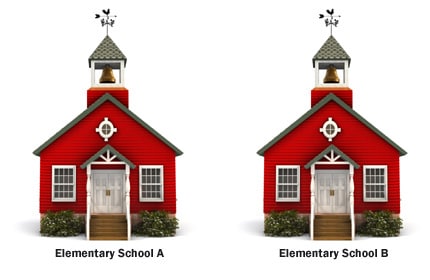
In 1896, the U.S. Supreme Court infamously upheld the legality of racial segregation and “Jim Crow” laws. Under the “separate but equal” doctrine, the Court said, public facilities could be lawfully segregated by race as long as both races had “equal” access. Fifty-eight years later, however, in the landmark case of Brown vs. Board of Education, the Court reversed itself, struck down the doctrine of “separate but equal” and required public schools to be integrated. The ruling, in which the Court observed that separate schools were by no means equal, was one of the seminal moments in the American civil rights movement.
Spring forward to August 2017, in my hometown in North Carolina where we have the tale of two schools that are once again separate but not equal. (Of course there are more than two such examples but for the sake of space, I will compare two elementary schools, 15 miles apart in the same school district.) The data to compare the two schools come from the website, www.greatschools.org .
Elementary School A has nearly 300 students. Eighty-eight percent are students of color. Four percent are white and 8% are listed as “other.” Ninety-nine percent of students are identified as low income. Test results are “very concerning” according to the website as only 35% of students are on or above grade level in reading and only 29% in math.
Elementary School B has nearly 700 students. Eighty percent are white students, 9% are students of color and 11% are other. Fourteen percent of students are identified as low income. Test results are “good news” according to the website with 79% of students on or above grade level in reading and 85% in math.
There are some commonalities between these two schools. They are held accountable for the same curriculum, the same pacing guide and the same standardized exam. But that is where it ends. Based predominantly (80%) on that exam, School A is labeled “D” and “Low Performing.” School B is labeled “A” and, according to www.schooldigger.com, is ranked 38th out of more than 1400 elementary schools in North Carolina.
So, based on these two schools, what is the relationship between income level and test scores, otherwise called “achievement”? What is the relationship between race and achievement? What is happening in these two schools that are only 18 minutes away from each other in the same school district? Why does the community (and the local real estate industry) call School B a “good school” but not School A? And finally, if School A is in crisis why isn’t there a sense of urgency to help these students succeed?
Equity and excellence in education have been and continue to be civil rights issues for marginalized students of color and/or in poverty. In 1999, Jean Anyon published her book, Literacy with an Attitude: Educating Working Class Children in their Own Self-Interest. In her study, she examined 5th grade classrooms in five distinctly different school districts based on parents’ income. For many, the results were surprising and yet for many of us, it confirmed what we already knew. The quality of instruction students received was directly related to the income level of the parents.
In working class schools (like School A) knowledge was taught as isolated facts separated from the lives and experiences of the students. Work was about following steps in a procedure. Students were given little choice and few opportunities to make decisions within their work and teachers rarely explained why or how assignments were meaningful. The teachers skipped assignments, text pages or reasoning problems that they assumed were too difficult for the students. Typical assignments were copying notes, writing answers to textbook questions or craft projects. There were few opportunities for dialogue between students. Teachers’ efforts were focused on control of students and teachers would make derogatory comments about student abilities, dispositions or parents/guardians.
In these schools, the theme for students was resistance. Students vandalized property, interrupted the teacher, fell out of chairs and refused to answer questions. The students were developing a relationship with authority and the broader economy that was preparing them for work as laborers.
In affluent schools (like School B) teachers designed lessons that were inquiry-based and required students to think for themselves and construct their own understandings. It was okay for students to give an incorrect answer because the focus was on the discussion that followed and making sense of errors. Many times, work was project-based and integrated arts and creativity. Students discussed current events and experiences that related to their lives and communities.
Instead of control, students and teachers consistently negotiated. Teachers rarely gave orders but would describe consequences of actions and ask students to make good decisions. If students felt they needed more time to work on a project, they would ask the teacher for it. Work was not repetitive and the emphasis was on thinking.
Anyon observed that the theme for the affluent school was individualism. The students in this school were also developing a relationship to the economy, authority and work. They would aspire to be artists, intellectuals, legal or scientific experts and other professionals who are rewarded with social power.
Martin Haberman would name this same dichotomy of instruction as the “Pedagogy of Poverty versus Good Teaching.” The pedagogy of poverty included assigning work, giving feedback and expecting correct answers. Good teaching would include student choice, project work and discovery and dialogue.
We know from decades of research that the type of instruction in these schools is vastly different. We also know some of the probable reasons why. School A has difficulty recruiting and retaining teachers. Not all teachers have the expertise and experience to be culturally responsive and work effectively with children of poverty or varying cultural backgrounds.
School A also has limited resources; if not monetarily, in human resources, facilities and teaching materials. Because it is a school in poverty, School A will most likely be deemed “low performing” and thus labeled and characterized as a poor school. Its reputation precedes it. Expectations will be low based on biases and assumptions. Students may enter School A already a year or more behind due to their limited access to high quality Pre-K programs and wrap around services such as healthcare and vision care, as well as simple food scarcity.
To combat being “behind,” districts will mandate more assessments that take away from instruction. They will demand teachers keep up with a pacing guide and implement prescriptive programs which take away teacher autonomy and diminish the teacher as a trusted professional. Low performing schools are watched and supervised – which adds a level of fear and stress. In North Carolina, these schools are given time to “turn around” and if they don’t, they can be taken over by the state or, as of this year, a charter school operator.
If I, as a teacher educator, were asked to intervene with School A, I would want to create a different culture by allowing teachers the opportunity to be professionals, by giving them ample opportunities for professional development and growth, and by providing them with tools and strategies for “good teaching.” Instead, our current legislature is doing or has done the following:
- Labeling schools A-F based predominantly on end of grade tests,
- Providing zero funding for professional development for teachers,
- Eliminating almost every teacher assistant,
- Continuing a cycle of assessment that is burdensome and takes away from instructional time,
- Narrowing the curriculum (due to testing as well as less art, music, physical education, social studies and science in K-5),
- Providing minimal raises to experienced teachers,
- Eliminating incentives for teachers to seek a master’s degree,
- Defunding public education and encouraging families to go to private schools through a voucher system,
- Refusing to expand Medicaid so that there is more emphasis on school nurses,
- De-professionalizing the teaching profession which impacts enrollment in teacher education programs, and
- Providing a lack of proper funding for high quality pre-K programs.
So how can we sum up our tale of the two schools? We know that School A and School B are not equitable. We also know that in many cases, School A is not provided with the same rigor and expectations as School B. We are, in short, dealing with a civil rights issue of great magnitude.
Why then, are so many North Carolinians and their elected representatives in the General Assembly failing to act with a sense of urgency or, even worse, not acting at all? Could it be because their children aren’t in School A?
Each year that goes by without proper intervention, collaboration with experts in the field, and policy input from teachers, thousands of children are in peril. In such an environment, it is time to revisit our Supreme Court decisions and have honest, open civil discourse about why we allow this tale to be non-fiction.
Editor’s Note: This article was published by NC Policy Watch on August 21, 2017.
